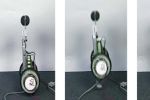So Smooth, it Hertz
If you’ve seen Sony’s Z-series of Bravia TVs, you’re probably wondering what 200Hz means, and why it’s suddenly such an amazing feature that you can’t live without. To understand why 200Hz is both a great example of marketing speak and a feature that you do want on your next TV, you need to understand a little bit about how TVs work.
In Australia, we use the PAL standard for our TVs. Among other things, the PAL spec has a refresh rate of 50Hz (as opposed to the NTSC spec of 60Hz found in the US and Japan). On your old CRT TV, that would mean that the picture would change 50 times every second (alternating between every second line every half a second).
When CRTs were introduced to 100Hz technology, it meant that the TV would double the frame rate, refreshing the picture twice as quickly by displaying each frame twice and therefore reducing visible flicker on screen.
100Hz technology works a little differently on LCDs and plasmas. For these TVs, each frame from the video source is analysed by a video-processing chip. The chip creates a hybrid image of the two frames, and inserts it between them. The end result is a slightly more fluid representation of motion, which is particularly beneficial to LCD screens.
Sony’s MotionFlow 200Hz Z-series Bravia TV takes this idea to the next obvious level – doubling the frame rate again. So instead of inserting just one frame between the two source images, the video chip inserts three different frames that are digitally composed to show the transformation from one frame to the next. And because there are now four frames displayed for every one coming from your source input, you get much smoother motion, making sports and fast-paced action much more enjoyable to watch.
As 2009 rolls on, expect more and more TV manufacturers to roll out 200Hz television sets. And then expect some all new breathtaking technology to be introduced as the next must-have feature… Because if there’s one certainty about digital televisions, it’s that they just keep on getting better.
Nick Broughall is the editor of Gizmodo Australia at gizmodo.com.au. He wrote this article for the February issue of Popular Science.
1 Comment
Popular Tags
Regular Features

Featured
Gear & Gadgets
The MegaGoods Roundup
Our biggest collection yet: over 200 of the year's best gadgets, goods and gizmosBattle of the Ultra-Mobile Linux Laptops: Cloudbook vs. EeePC vs. My Old Thinkpad
How much portable Linux goodness can you get for $400?
Popular on Popsci
Most Viewed
Gear & Gadgets
- Yamaha's Digital Grand Piano
- Finger Flickin’ Good
- A Touch-Sensitive Rubik's Cube
- Welcome to Obsolescence. Population: Me
- Two Words Photographers Love: Big Sensor
- Why Lenses Are the Real Key to Stunning Photos
- New Eye-Fi Cards Upload Video Wirelessly from Most Any Camera
- Nintendo DSi Aussie Release Date Set
- Best Home Server Software
- Make Windows XP Look Like Windows 7 (No Hacking Required)
Most Commented
Gear & Gadgets
- How Broke Would You Have to Be to Revert Back to Dial-Up?
- New HP Enjoys Being Felt Up
- Vista SP2 Release Candidate Now Available
- The Great Pyramid PC Would Make Tutankhamun Jealous
- Get Clean and Get Probed By the Aquapeutics Shower
- So Smooth, it Hertz
- Will Windows 7 Finally Make Mobile Broadband Reliable?
- Why Lenses Are the Real Key to Stunning Photos
- A Touch-Sensitive Rubik's Cube
- Five Best Live CDs
Most Emailed
Gear & Gadgets
- Get Clean and Get Probed By the Aquapeutics Shower
- A Touch-Sensitive Rubik's Cube
- Vista SP2 Release Candidate Now Available
- Kogan Release Budget 37-inch TV
- The Great Pyramid PC Would Make Tutankhamun Jealous
- Apple Updates Desktops, Introduces Wired Mini Keyboard
- New Eye-Fi Cards Upload Video Wirelessly from Most Any Camera
- So Smooth, it Hertz
- Will Windows 7 Finally Make Mobile Broadband Reliable?
- Two Words Photographers Love: Big Sensor









Comments
The 200Hz is awesome as! I've seen the picture quality and it simply blows you away. The difference between this and the ordinary 100Hz models is clear when watching fast action sports, with less lagginess and sharper pictures on the 200Hz model.
Now we just have to wait until this technology becomes more common before buying for a decent price :)
0 out of 0 people found this comment helpful